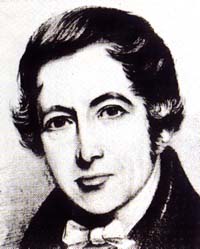Andrew Crosse
| Andrew Crosse | |
|---|---|

Andrew Crosse
|
|
| Born |
17 July 1784 Fyne Court, Broomfield, Somerset, UK |
| Died | 6 July 1855 (aged 70) Fyne Court, Broomfield, Somerset, UK |
| Nationality | British |
| Occupation | Amateur scientist |
| Known for | Electrocrystallization |
| Spouse(s) |
|
| Children | 10 |
Andrew Crosse (17 June 1784 – 6 July 1855) was a British amateur scientist who was born and died at Fyne Court, Broomfield, Somerset. Crosse was an early pioneer and experimenter in the use of electricity. He became widely known after press reports of an electrocrystallization experiment he conducted in 1836, during which insects "appeared".
Crosse was the first son of Richard Crosse and Susannah Porter. In 1788 he accompanied them on a trip to France, where he went to school for a time in Orléans. From the age of six until he was eight he stayed with a tutor, the Reverend Mr White, in Dorchester, where he learned Greek. On 1 February 1792 he was sent to boarding school in Bristol.
Around the age of 12 Crosse persuaded one of his teachers to let him attend a series of lectures on the natural sciences, the second of which was on the subject of electricity. This led to his lifelong interest in the subject. Crosse first started experimenting with electricity during his time in the sixth form, when he built a Leyden jar. After leaving school he studied at Brasenose College, Oxford.
Having lost his parents, his father in 1800 and his mother in 1805, Crosse took over the management of the family estates at the age of 21. After abandoning his studies for the Bar, he increasingly devoted his spare time to studying electricity at Fyne Court, where he built his own laboratory. He also studied mineralogy and became interested in the formation of crystalline deposits in caves. Around 1807 he started to experiment with electrocrystallization, forming crystalline lime carbonate from water taken from Holwell Cavern. He returned to the subject again from around 1817 and in subsequent years produced a total of 24 electrocrystallized minerals.
Among his experiments Crosse erected "an extensive apparatus for examining the electricity of the atmosphere," incorporating at one point an insulated wire some 1.25 miles (2.01 km) long, later shortened to 1,800 feet (550 m), suspended from poles and trees. Using this wire he was able to determine the polarity of the atmosphere under various weather conditions. His results were published by his friend George Singer in 1814, as part of Singer's Elements of Electricity and Electro-Chemistry.
...
Wikipedia
